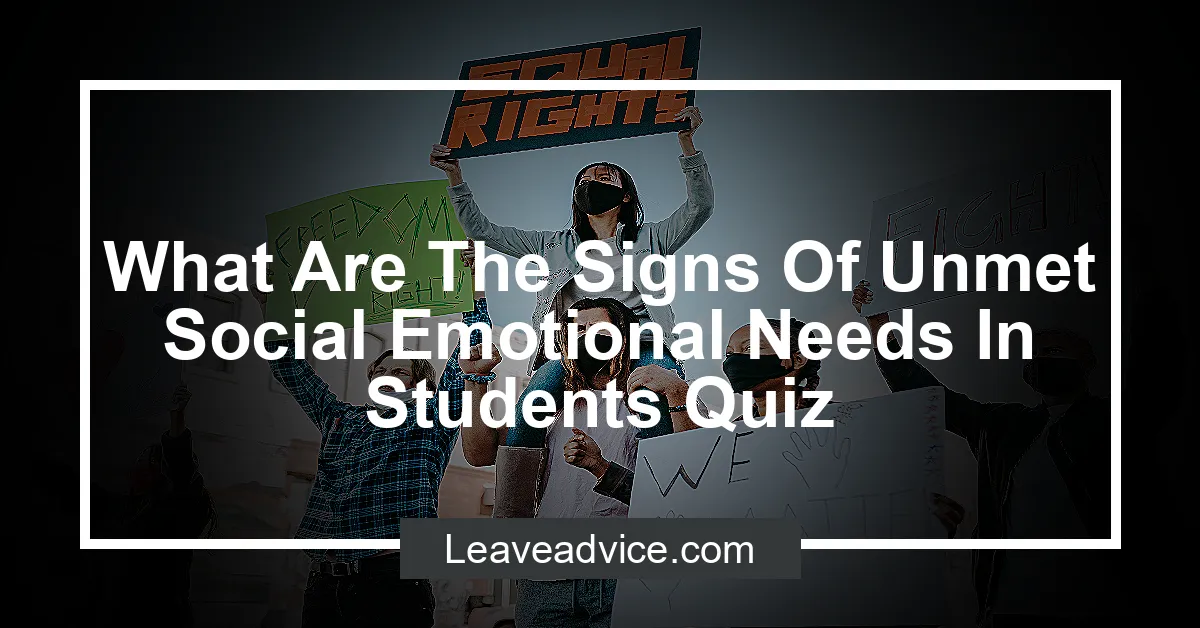What Are The Signs Of Unmet Social Emotional Needs In Students Quiz


Unmet social emotional needs in students refer to the lack of support and resources to help them develop skills like self-awareness, self-management, social awareness, responsible decision making, and relationship skills. It is important to address unmet social emotional needs in students because neglecting to do so can lead to negative outcomes such as exclusionary discipline, mental health concerns, and challenges in accessing and participating in learning.
Research has shown that addressing these needs is foundational to a child’s academic success and overall well-being.
Understanding Social Emotional Needs
What are social emotional needs?
Social emotional needs are the fundamental requirements for individuals to understand and manage their emotions, maintain healthy relationships, and make responsible decisions. These needs encompass self-awareness, self-regulation, empathy, and social skills, which are essential for overall well-being and successful interaction with others.
The impact of unmet social emotional needs on student development
Unmet social emotional needs in students can lead to a range of negative outcomes, including poor academic performance, behavioral issues, and increased risk of mental health challenges such as anxiety and depression. When students lack the necessary support and guidance to address their social emotional needs, it can hinder their ability to engage effectively in learning, navigate social interactions, and cope with various stressors, ultimately impacting their overall development and well-being.
| Impacts of Unmet Social Emotional Needs |
|---|
| Poor academic performance |
| Behavioral challenges |
| Increased risk of mental health issues |
Addressing social emotional needs is crucial for fostering a positive learning environment and supporting students’ holistic development.
Common Signs of Unmet Social Emotional Needs in Students
Withdrawal and isolation: Students with unmet social emotional needs may exhibit withdrawal and isolation, avoiding social interaction and feeling disconnected from their peers. This manifests as spending excessive time alone, avoiding group activities, and showing disinterest in forming friendships.
Aggressive behavior: Unmet social emotional needs can lead to aggressive behavior in students, including verbal outbursts, physical aggression, and confrontational attitudes towards peers and authority figures. This can be a manifestation of underlying emotional distress and frustration.
Difficulty in maintaining relationships: Students experiencing unmet social emotional needs may struggle to maintain healthy and positive relationships. They may have trouble trusting others, forming meaningful connections, and may demonstrate difficulties in understanding social cues.
Low self-esteem and self-worth: Students with unmet social emotional needs often exhibit low self-esteem and lack of self-worth, leading to self-doubt, negative self-perception, and reluctance to engage in activities that require self-confidence.
Lack of empathy: Unmet social emotional needs can result in a lack of empathy in students, making it challenging for them to understand and relate to the emotions and experiences of others. They may demonstrate difficulty in recognizing and responding to the feelings of their peers.
Poor academic performance: Students with unmet social emotional needs may struggle academically, exhibiting a decline in their academic performance, lack of interest in learning, and difficulty concentrating on their studies.
The Role of Educators and Parents
Recognizing signs of unmet social emotional needs
Recognizing signs of unmet social emotional needs in students may include social withdrawal, lack of confidence, and slow-to-warm-up behavior in new situations. Educators and parents should be observant of these behaviors to identify potential unmet social emotional needs.
Creating a supportive and inclusive environment
Educators and parents play a crucial role in creating a supportive and inclusive environment for students. This can be achieved by fostering a safe and welcoming learning environment for all children, regardless of their background, and by encouraging choice-making during play to promote child independence.
The importance of open communication
Open communication is imperative in addressing social and emotional needs. Encouraging daily communication with parents, conducting regular parent-teacher conferences, and involving parents in their child’s development can foster an environment where students feel comfortable sharing their thoughts and seeking assistance when needed.
Seeking professional help when needed
When signs of unmet social emotional needs persist, seeking professional help is vital. It is important to address the emotional well-being of students and be prepared to support them effectively.
This may involve working with mental health professionals to ensure the students receive the necessary support and care.
| Key Points |
|---|
| Signs of Unmet Social Emotional Needs |
| • Social withdrawal |
| • Lack of confidence |
| • Slow-to-warm-up behavior |
| Creating a Supportive Environment |
| • Fostering a safe and welcoming learning environment |
| • Encouraging choice-making during play |
| Importance of Open Communication |
| • Daily communication with parents |
| • Regular parent-teacher conferences |
| Seeking Professional Help |
| • Addressing emotional well-being |
| • Collaboration with mental health professionals |
Strategies for Addressing Unmet Social Emotional Needs
Implementing social emotional learning programs:
Implementing evidence-based social emotional learning programs, such as CASEL’s recommended interventions, can provide a structured framework for addressing the unmet social emotional needs of students. These programs offer a systematic approach to developing emotional intelligence, self-awareness, and interpersonal skills, fostering a positive school climate.
Providing individualized support and intervention:
Offering personalized support and intervention tailored to each student’s specific social emotional needs is crucial. This may involve conducting individual assessments to identify areas of concern and creating personalized plans that address their unique emotional struggles.
Utilizing interventions like Positive Behavioral Interventions and Supports (PBIS) can aid in providing targeted support for students requiring individualized attention.
Encouraging peer support and positive interactions:
Creating an environment that encourages peer support and positive interactions among students plays a pivotal role in addressing unmet social emotional needs. Implementing group activities, mentoring programs, and peer counseling initiatives fosters a sense of community and belonging, providing avenues for students to support one another through challenges.
Positive interactions enhance social skills, empathy, and emotional resilience.
Teaching coping skills and emotional regulation techniques:
Incorporating explicit teaching of coping skills and emotional regulation techniques into the curriculum equips students with essential tools to navigate their emotions effectively. Providing instruction on mindfulness, relaxation techniques, and conflict resolution empowers students to manage stress, regulate their emotions, and navigate social interactions successfully.
This proactive approach helps mitigate the impact of unmet social emotional needs.
| Comparison of Strategies | |
|---|---|
| Implementing social emotional learning programs | Provides a structured framework for addressing social emotional needs |
| Providing individualized support and intervention | Tailors assistance based on individual student requirements |
| Encouraging peer support and positive interactions | Fosters a supportive community within the student body |
| Teaching coping skills and emotional regulation techniques | Equips students with essential tools for managing emotions |
By adopting these strategies, educational institutions can effectively address the unmet social emotional needs of students, nurturing a supportive and emotionally healthy learning environment.
Remember, addressing social emotional needs is pivotal for fostering a conducive learning environment in schools and promoting overall student well-being.
Case Studies and Examples
Real-life examples of students with unmet social emotional needs
In one instance, a student struggling with unmet social emotional needs exhibited withdrawal from social interactions, reluctance to participate in group activities, and a general disengagement from learning. This student’s emotional distress was evident in their difficulty expressing feelings and building relationships with peers, causing a decline in academic performance and overall well-being.
Another real-life example involved a student showing signs of unmet social emotional needs through disruptive and impulsive behaviors, frequent outbursts, and challenges in managing emotions. The student found it challenging to regulate their feelings, leading to conflicts with peers and teachers, hindering their social and academic development.
Success stories of addressing social emotional needs in students
In contrast, a heartwarming success story showcased a student’s remarkable transformation after receiving targeted support for their social emotional needs. Through dedicated mentoring, counseling, and tailored interventions, the student exhibited improved self-regulation, enhanced social skills, and a renewed enthusiasm for learning, ultimately experiencing a positive shift in academic performance and interpersonal relationships.
Additionally, a success story highlighted a student who, after participating in a comprehensive social emotional learning program, demonstrated enhanced empathy, effective communication, and proactive problem-solving abilities. This positive change not only benefited the student’s academic achievement but also contributed to a harmonious classroom environment and strengthened peer interactions.
Impact of Addressing Unmet Social Emotional Needs
Improved academic performance
Addressing unmet social-emotional needs in students can lead to remarkable improvements in academic performance. By providing a supportive and inclusive environment, students feel more engaged, focused, and motivated to learn.
When emotional well-being is prioritized, students are better equipped to manage stress and anxiety, leading to enhanced cognitive functioning, improved concentration, and better academic outcomes.
Enhanced social skills and relationships
Focusing on unmet social-emotional needs fosters the development of essential social skills and positive relationships among students. By promoting empathy, communication, and cooperation, students become more adept at navigating interpersonal dynamics.
As a result, they are better equipped to build meaningful relationships, collaborate effectively, and handle conflicts constructively, creating a harmonious and conducive learning environment.
Boosted self-esteem and confidence
Addressing unmet social-emotional needs plays a pivotal role in boosting students’ self-esteem and confidence. When students feel valued, understood, and supported, they develop a strong sense of self-worth and resilience.
Embracing inclusion and empathy enables students to gain confidence in expressing themselves, embracing their uniqueness, and confidently engaging in various social and academic activities.
Long-term benefits for mental health and wellbeing
Addressing unmet social-emotional needs in students lays the foundation for long-term mental health and overall well-being. By nurturing an environment that promotes emotional intelligence, empathy, and resilience, students are better equipped to cope with life’s challenges, reducing the risk of mental health issues in the long run.
Moreover, by addressing these needs early, students are more likely to develop positive coping mechanisms and emotional regulation skills that contribute to overall mental well-being in the future.
The Importance of Self-Care for Educators and Parents
In the fast-paced world of education, the well-being of educators and parents is often overlooked. However, it is of utmost importance as it directly impacts their ability to support students with unmet social emotional needs.
Educators and parents who neglect self-care may find it challenging to provide the necessary support and understanding to students facing emotional struggles.
Amidst recognizing the impact of supporting students with unmet social emotional needs, it is crucial for educators and parents to understand the signs, such as isolation, disengagement, and behavioral inconsistencies. By recognizing these signs, they can intervene early and provide the necessary support to help students navigate their emotional needs effectively.
When it comes to coping strategies for educators and parents, implementing mindfulness practices, maintaining a healthy work-life balance, and seeking support from fellow educators and parents can be immensely beneficial. These strategies help in retaining emotional stability and resilience, allowing them to better support their students through challenging times.
Moreover, seeking support and resources for self-care is equally important. Educators and parents can benefit from workshops, counseling services, and even online resources that focus on mental health awareness and self-care techniques.
By availing such support, they can ensure they are equipped to handle the emotional needs of their students while maintaining their own well-being.
| Coping Strategies | Description |
|---|---|
| Mindfulness Practices | Implementing mindfulness techniques to enhance emotional stability. |
| Healthy Work-Life Balance | Ensuring a balanced approach to work and personal life for mental well-being. |
| Supportive Networks | Seeking guidance and support from fellow educators and parents. |
By prioritizing self-care, educators and parents are not only improving their own well-being but also enhancing their ability to support students with unmet social emotional needs, creating a more nurturing and supportive educational environment.
Criticisms and Misconceptions
Addressing common misconceptions about social emotional needs in students:
One common misconception about social-emotional learning (SEL) is that it only teaches kids about feelings. However, emotional intelligence is just one aspect of SEL, which involves teaching a wide array of skills including relationship management, decision-making, and empathy.
Another misconception asserts that social-emotional skills aren’t as crucial as “hard skills.” In reality, social-emotional skills, often termed as “soft skills,” are equally essential for a student’s holistic development and success in their personal and professional lives.
Responding to criticisms of addressing unmet social emotional needs in education:
Critics sometimes argue that SEL is a waste of academic time, disassociating it from academic success. However, numerous studies and real-world examples demonstrate how SEL improves students’ academic performance, behavior, and overall well-being.
Another criticism is that social-emotional learning takes away from academics, suggesting that toughening up is a more appropriate approach. Yet, integrating SEL into education has shown positive outcomes, embodying the idea that nurturing social and emotional skills complements academic growth rather than hindering it.
The Role of Policy and Advocacy
Dear readers, the role of policy and advocacy in addressing unmet social emotional needs in students is crucial. It involves advocating for the inclusion of social emotional learning in the curriculum to ensure that students receive the necessary support for their emotional well-being.
This can lead to the formulation of policy recommendations aimed at supporting students with unmet social emotional needs, providing a structured framework for intervention and assistance.
Advocating for the inclusion of social emotional learning in the curriculum creates an environment where students’ emotional needs are given the attention they deserve. It ensures that schools prioritize emotional well-being as an integral part of education, paving the way for a holistic approach to student development.
Policy recommendations for supporting students with unmet social emotional needs involve setting guidelines and procedures to identify, address, and provide necessary assistance to students facing emotional challenges. It encompasses the establishment of support systems within educational institutions and the implementation of targeted interventions to cater to the diverse emotional needs of students.
Collaborating with stakeholders for systemic change is essential for creating a supportive ecosystem that addresses unmet social emotional needs in students comprehensively. It involves engaging with educators, parents, mental health professionals, and policymakers to develop a collective approach towards promoting students’ emotional well-being.
The role of policy and advocacy in addressing unmet social emotional needs in students is pivotal. By advocating for the incorporation of social emotional learning in the curriculum, formulating policy recommendations, and collaborating with stakeholders, a conducive environment is created to support students in overcoming social emotional challenges.
This multi-faceted approach lays the foundation for a holistic support system that prioritizes the emotional well-being of students.
| Advocating for the inclusion of social emotional learning in curriculum | Policy recommendations for supporting students with unmet social emotional needs | Collaborating with stakeholders for systemic change |
|---|---|---|
| Prioritizes emotional well-being in education | Establishes structured support frameworks | Engages diverse stakeholders for collective support |
Resources for Educators, Parents, and Students
Recommended books, articles, and websites for further reading
- “The Invisible Boy” by Patrice Barton
- “Enemy Pie” by Derek Munson
- “The Memory String” by Eve Bunting
- “Don’t Think About Purple Elephants” by Susanne
Support groups and organizations focused on social emotional needs in education
- ASCD Whole Child Initiative
- CASEL
- Center for Advanced Study in the
Workshops and training programs for educators and parents
- Introduction to Social and Emotional Learning-This one hour, virtual learning experience
- Institute for Social & Emotional Learning (IFSEL) facilitates training, professional development, and curriculum
- Free Social Emotional Learning Webinars by Empowering Education
| Example | Description |
|---|---|
| “The Invisible Boy” by Patrice Barton | A book promoting kindness and empathy among students |
| ASCD Whole Child Initiative | Organization supporting comprehensive approaches to education, focusing on social and emotional learning |
| Introduction to Social and Emotional Learning | Virtual learning experience providing practical application activities for educators and parents |
Keep learning, growing, and making a difference for our future generations!
Recommended Amazon Products for Addressing Unmet Social Emotional Needs in Students
Here’s a curated list of products that can help address unmet social emotional needs in students with ease. These recommendations are based on the criteria of functionality, price, and reviews.
1. Calm Down Corner Kit
- Description: This kit contains various tools and resources to help students regulate their emotions, including stress balls, fidget toys, calming essential oils, and visual timers.
- Calm Down Corner Kit


2. Social Emotional Learning Books
- Description: There are numerous books available on Amazon that provide guidance and activities for teachers and parents to support students’ social and emotional development.
- Social Emotional Learning Books


3. Feelings Flashcards
- Description: These flashcards are designed to help students recognize and understand their emotions, as well as develop empathy and social skills.
- Feelings Flashcards


4. Mindfulness Activity Cards
- Description: These cards offer a variety of mindfulness exercises and activities to help students manage stress, improve concentration, and develop emotional awareness.
- Mindfulness Activity Cards


5. Comfortable Sensory Chair
- Description: A specially designed chair that provides a comfortable and calming space for students who may need a sensory-friendly seating option.
- Comfortable Sensory Chair


Top Recommended Product for Addressing Unmet Social Emotional Needs in Students
If you’re looking for the best solution for addressing unmet social emotional needs in students, we highly recommend the Calm Down Corner Kit. Here’s why:
| Pros | Cons |
|---|---|
| Contains a variety of calming tools and resources | May not be suitable for all age groups |
| Positive reviews for effectiveness in supporting emotional regulation | May require teacher/parent training for optimal use Affordable and comprehensive solution |
| Can be used in both classroom and home settings |
Ready to improve students’ social emotional needs? Check out the Calm Down Corner Kit today for the best results!


Conclusion
The signs of unmet social-emotional needs in students can manifest as frequent outbursts, mood swings, and difficulty in managing emotions. These behaviors can be indicative of an underlying need for support and intervention to address their emotional well-being.
Moreover, students with unmet social-emotional needs may also exhibit withdrawal from social interactions, reluctance to participate in group activities, and a lack of interest in forming relationships with their peers. These signs may signal the need for targeted interventions to foster a sense of belonging and connectedness within the school community.
Furthermore, academic struggles, decreased motivation, and a decline in overall performance may be indicators of unmet social-emotional needs in students. Addressing these signs through targeted support and interventions can help students develop the necessary skills to navigate their emotions and thrive in their academic and social pursuits.













